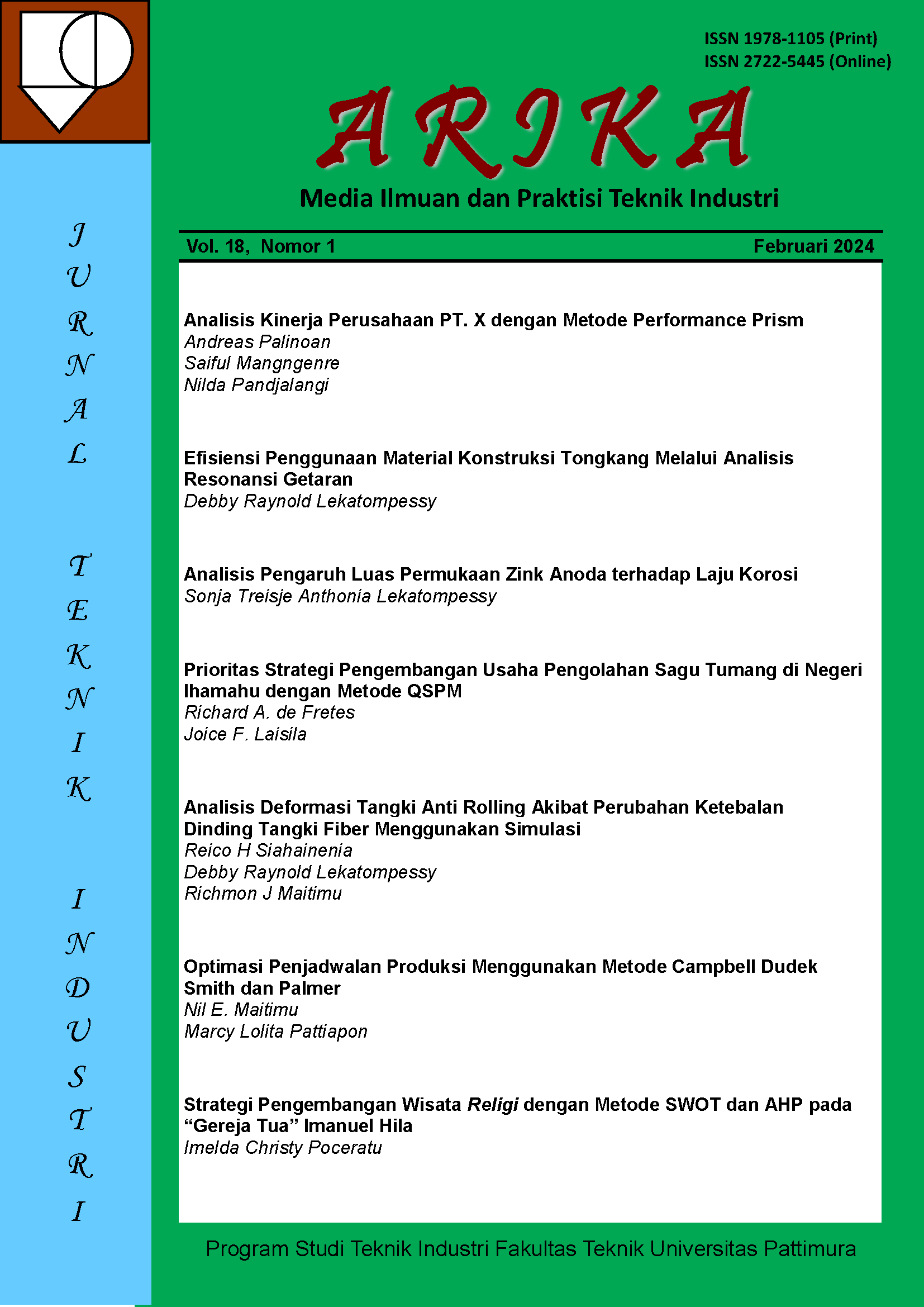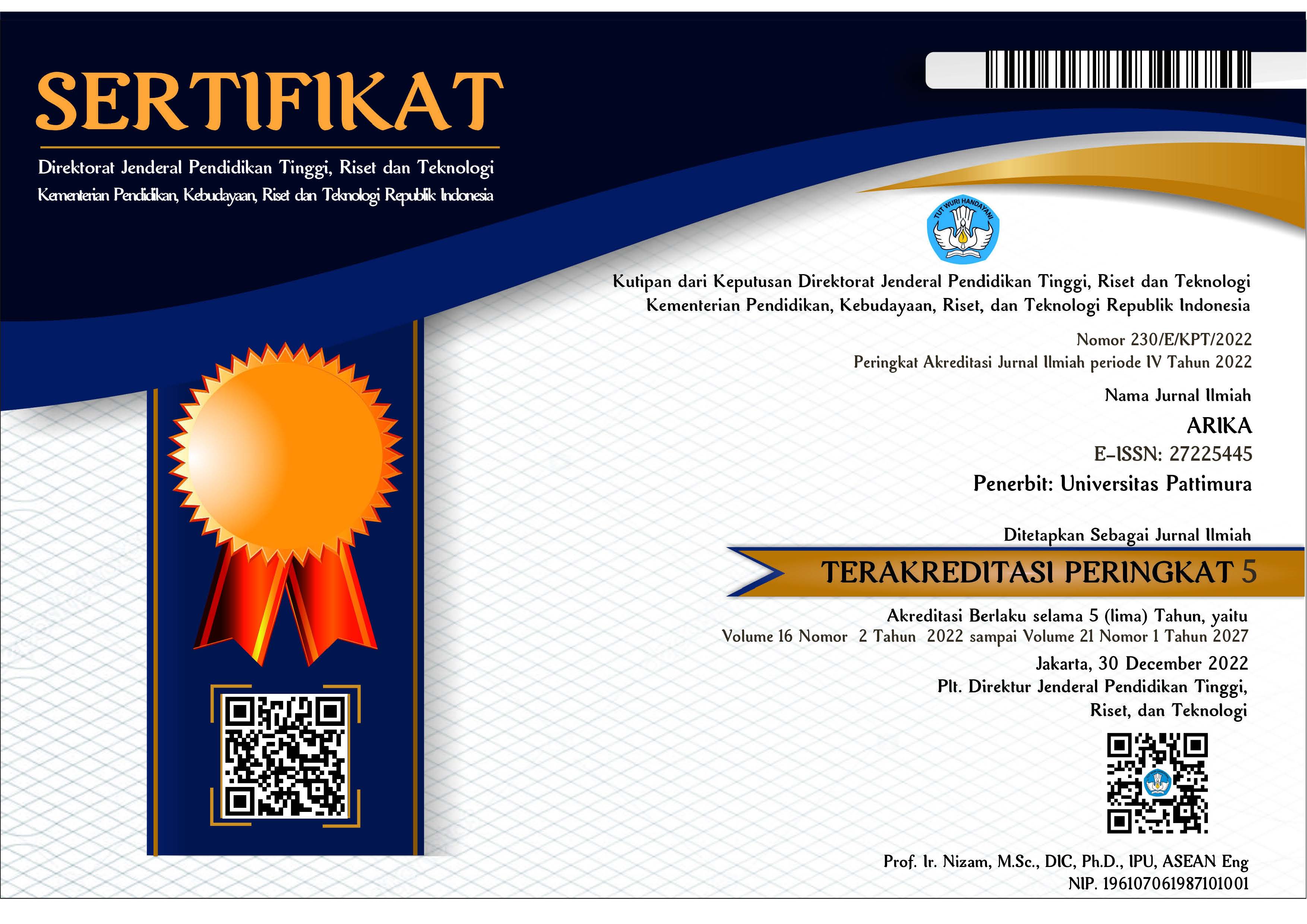Analisis Deformasi Tangki Anti Rolling Akibat Perubahan Ketebalan Dinding Tangki Fiber Menggunakan Simulasi
Abstract
Penambahan tangki anti rolling pada kapal kayu tradisional menjadi penting ketika banyak kecelakaan jenis kapal ini diakibatkan stabilitas kapal yang menjadi buruk karena penempatan muatan di atas geladak kapal. Salah satu solusi yang dapat dilakukan adalah dengan membuat tangki anti rolling yang diletakkan pada bagian tengah kapal ini. Tangki anti rolling yang digunakan harus kuat dalam menerima beban kerja akibat gaya tekan hidrostatis air yang ada di dalamnya. Kemampuan tangki dalam menerima beban kerja bergantung pada kondisi tangki. Pada penelitian ini dilakukan analisis deformasi yang terjadi akibat perubahan ketebalan tangki bermaterial Fiber Reinforced Plastic (FRP) yang digunakan sebagai tangki anti Rolling. Deformasi mengindikasikan kondisi kemampuan konstruksi tangki dalam menerima beban yang bekerja. Ketebalan tangki Perhitungan dilakukan menggunakan metode Finite Element Analysis (FEA) dengan bantuan software. Ketebalan tangki FRP yang digunakan adalah 5 mm – 12 mm. Berdasarkan variasi ketebalan dinding FRP tangki anti rolling maka nilai deformasi yang diperoleh berturut-turut adalah sebagai berikut, 5 mm deformasi yang terjadi sebesar 0,613 mm, 7,5 mm deformasi yang terjadi sebesar 0,166 mm, 10 mm deformasi yang terjadi sebesar 0,060 mm, 12 mm deformasi yang terjadi sebesar 0,042 mm. Sehingga ketebalan yang terbaik ada di 12 mm dengan deformasi terkecil. Secara teknis hal ini adalah hasil yang terbaik, tetapi secara ekonomis penambahan ketebalan berdampak pada faktor ekonomis dimana semakin tebal material tangki akan menambah volume LWT yang artinya mengurangi daya muat kapal. Harus dipikirkan solusi lain agar penambahan volume material dinding dapat ditekan dengan menggunakan penguat struktur lainnya yang lebih ringan.
Downloads
References
Bhattacharyya, R. (1978). Dynamics of Marine Vehicles. Wiley.
Cercos-Pita, J. L., Bulian, G., Pérez-Rojas, L., & Francescutto, A. (2016). Coupled simulation of nonlinear ship motions and a free surface tank. Ocean Engineering, 120, 281–288. https://doi.org/10.1016/j.oceaneng.2016.03.015
Chen, C., Liu, Y., Zhang, W., He, Y., & Tang, Y. (2023). Free roll decay simulation of a polar research vessel with an anti-roll tank based on CFD. Ocean Engineering, 285, 115429. https://doi.org/10.1016/j.oceaneng.2023.115429
Das, A., Maity, D., & Kumar Bhattacharyya, S. (2022). Investigation on the efficiency of deep liquid tanks in controlling dynamic response of high-rise buildings: A computational framework. Structures, 37, 1129–1141. https://doi.org/10.1016/j.istruc.2022.01.077
Fomin, O., Lovska, A., Bohomia, V., & Berestovoi, I. (2022). Determination of dynamic loading of a tank wagon with malleable links between the pot and the frame. Procedia Structural Integrity, 36, 239–246. https://doi.org/10.1016/j.prostr.2022.01.030
George, A., & Cho, I.-H. (2021). Anti-slosh effect of a horizontal porous baffle in a swaying/rolling rectangular tank: Analytical and experimental approaches. International Journal of Naval Architecture and Ocean Engineering, 13, 833–847. https://doi.org/10.1016/j.ijnaoe.2021.10.001
Lekatompessy, D. R. (2021). The effect analysis of the stiffness changes of a Traditional Fishing Boat Foundation on Vibration Amplitude. TEKNIK, 42(1), 71–78. https://doi.org/10.14710/teknik.v42i1.30978
Lekatompessy, D. R. (2023a). Analysis of rubber as reduction vibration material on FRP ship walls. AIP Conference Proceedings, 2588(1), 040007. https://doi.org/10.1063/5.0111899
Lekatompessy, D. R. (2023b). Local vibration reduction of machine support systems through transmissibility pattern analysis in resonant construction. AIP Conference Proceedings, 2588(1), 040012. https://doi.org/10.1063/5.0111908
Lin, J., Guo, C., Zhao, D., Han, Y., & Su, Y. (2022). Hydrodynamic simulation for evaluating Magnus anti-rolling devices with varying angles of attack. Ocean Engineering, 260, 111949. https://doi.org/10.1016/j.oceaneng.2022.111949
Lin, J.-F., Han, Y., Su, Y.-M., Wang, Y., Zhang, Z.-T., & Jiang, R.-Q. (2021). Hydrodynamic performance of a Magnus anti-rolling device at zero and low ship speeds. Ocean Engineering, 229, 109008. https://doi.org/10.1016/j.oceaneng.2021.109008
Lutfi, Y. M., Adiputra, R., Prabowo, A. R., Utsunomiya, T., Erwandi, E., & Muhayat, N. (2023). Assessment of the stiffened panel performance in the OTEC seawater tank design: Parametric study and sensitivity analysis. Theoretical and Applied Mechanics Letters, 13(4), 100452. https://doi.org/10.1016/j.taml.2023.100452
Peshkov, R., Varkentin, V., Ismagilov, D., & Mikhailov, E. (2023). Study of Strength Properties of the Designed Tank for Marine Transportation of Liquefied Natural Gas in the Arctic Conditions. Transportation Research Procedia, 68, 819–824. https://doi.org/10.1016/j.trpro.2023.02.115
Siburian, Y. (2021). Kajian Eksperimental Penggunaan Tangki Anti-Rolling Terhadap Periode Rolling Kapal Kayu [Skripsi]. Pattimura.
Tafsirojjaman, T., Ur Rahman Dogar, A., Liu, Y., Manalo, A., & Thambiratnam, D. P. (2022). Performance and design of steel structures reinforced with FRP composites: A state-of-the-art review. Engineering Failure Analysis, 138, 106371. https://doi.org/10.1016/j.engfailanal.2022.106371
Vizentin, G., & Vukelic, G. (2022). Marine environment induced failure of FRP composites used in maritime transport. Engineering Failure Analysis, 137, 106258. https://doi.org/10.1016/j.engfailanal.2022.106258
Zingoni, A. (2015). Liquid-containment shells of revolution: A review of recent studies on strength, stability and dynamics. Thin-Walled Structures, 87, 102–114. https://doi.org/10.1016/j.tws.2014.10.016
Copyright (c) 2024 Reico H Siahainenia, Debby Raynold Lekatompessy, Richmon J Maitimu

This work is licensed under a Creative Commons Attribution-ShareAlike 4.0 International License.
An author who publishes in the ARIKA Jurnal agrees to the following terms:
- The author retains the copyright and grants ARIKA journal the right of first publication of the work simultaneously licensed under the Creative Commons Attribution-ShareAlike 4.0 License that allows others to share the work with an acknowledgment of the work's authorship and initial publication in this journal.
- The author is able to enter into separate, additional contractual arrangements for the non-exclusive distribution of the journal's published version of the work (e.g., post it to an institutional repository or publish it in a book) with the acknowledgment of its initial publication in this journal.
- The author is permitted and encouraged to post his/her work online (e.g., in institutional repositories or on their website) prior to and during the submission process, as it can lead to productive exchanges, as well as earlier and greater citation of the published work (See The Effect of Open Access).










